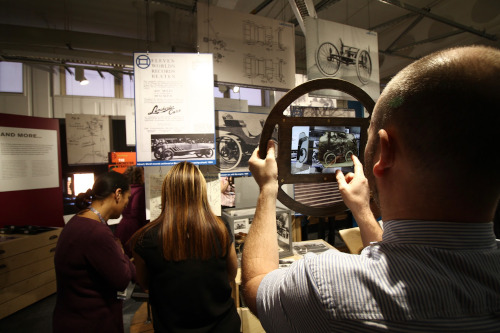The work of car manufacturer, engineer, scientist and inventor Frederick Lanchester (1868-1946) is celebrated by the Lanchester Interactive Archive (LIA) at Coventry University. He was a leading automobile engineer in the UK during the late 19th and early 20th centuries, and creator in 1895 of the first all-British four-wheel petrol driven motor car.
This work led to him building the first all-British motor boat in the 1890s and then the first outboard motor engine – because restrictive speed limits on roads meant that he could not carry out meaningful engine tests in cars.
![Frederick Lanchester at the wheel of the 8 h.p. two cylinder Lanchester car known as the ‘Gold Medal Phaeton’ with his brother George as passenger, c1899 [LAN/1/16/4].](http://libraryservices.jiscinvolve.org/wp/files/2020/03/lcov_phaeton.jpg)
![Frederick Lanchester with one of his model gliders used to make aerodynamic measurements, 1894 [LAN/7/4].](http://libraryservices.jiscinvolve.org/wp/files/2020/03/lcov_glider.jpg)
The Birmingham Small Arms Company bought the Lanchester Motor Company in 1930 and made it a subsidiary of Daimler, which meant the manufacture of Lanchester cars moved to Coventry. Lanchester continued to set benchmarks in car design, and his models were favoured by royalty, including King George VI. The last Lanchester cars were produced in the mid-1950s.
In early 2016 the LIA started to digitise much of the material in the collection, which is the largest Frederick Lanchester archive in the world. The LIA exhibition space in the university library had its official launch in April 2017. The project’s first phase (funded by the National Lottery and others) ended in April 2019, but the university continues to support the LIA.

Outreach work features augmented reality (AR) and virtual reality tools, projections and pop-up displays. Individuals and groups (e.g. schools, organisations and communities) come to the LIA space, and workshops are tailored for any age group.
The LIA space has touch screens that include interactive games and puzzles to explain the engineering and technical aspects of Lanchester’s work and his inventions, and visitors can point AR tablets at the exhibition images to produce additional information on the tablets. Visitors can also sit in a car built by one of the LIA consultants (Lanchester historian and enthusiast Chris Clark).
External visits also take place, and this has been strengthened by the university’s recent purchase of a 1932 Lanchester 15/18 car. It is planned to adapt the car into an outreach vehicle for events and visits, especially during 2021 Coventry City of Culture, and a small volunteer team of Lanchester enthusiasts are helping to keep the car in working order.

Over 21,000 images will eventually be available via the university’s online archives catalogue including personal and business correspondence, sketch books, pocket note books, copies of patent applications, blueprints, copies and manuscript originals of published works and a large collection of contemporary photographs of Lanchester cars and other vehicles. The catalogue has been updated recently to include a second series of Lanchester correspondence and the blueprints will be added later this year.
Other items that have not been catalogued yet include Lanchester family papers, objects, and donations from individuals and organizations such as the Lanchester Trust, a charity that supports the university’s Lanchester collection work.
The LIA aims to open up Lanchester’s archives and show their potential for research in a variety of subjects. One Coventry student was inspired by an 1897 Lanchester aircraft patent as part of his MSc in aerospace engineering. A flight simulation model was created of the manned flying machine, which was never built at the time. Advanced computer software then proved that Lanchester’s machine would have flown, and would have been more aerodynamically stable than the Wright brothers’ machine used in the world’s first powered flight. The simulation was among several designs showcased by Coventry University students at the 2018 Farnborough International Airshow.
![Illustration from the Frederick Lanchester patent for improvements in and relating to aerial machines, 1897 [LAN/6/34/10].](http://libraryservices.jiscinvolve.org/wp/files/2020/03/lcov_patent.jpg)
Gary Collins
Archivist, Coventry University
Explore Coventry University library’s collections on Library Hub Discover:
Browse the library records here
- Browse the archives records on Archives Hub
- Find out more about the library, including contact details and visitor information on its Discover information page.
All images copyright Coventry University (available via Creative Commons 4.0 license) and reproduced with the kind permission of the copyright holders.

